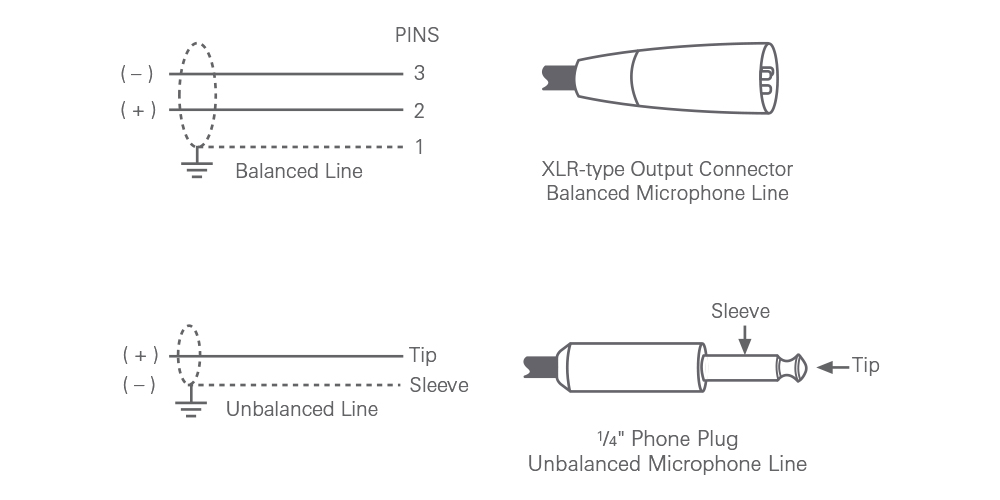A Brief Guide to Microphones - Important Microphone Characteristics
Impedance | Balanced and Phased | Sensitivity
Impedance
One important characteristic of a microphone is its output impedance. This is a measurement of the AC resistance looking back into the microphone. Generally, microphones can be divided into low (50–1,000 ohms), medium (5,000–15,000 ohms) and high (20,000+ ohms) impedance. Most Audio-Technica microphones are rated low-impedance. They’ll work directly into mixer inputs of 150 ohms on up to approximately 4,000 ohms, so they should be ideal for most of the tape recorders and mixers currently available. Of course, some users may want to use a low-impedance Audio-Technica microphone into a high-impedance (50,000 ohms) input, which is why we offer a microphone line matching transformer. It should be located as close to the electronic input as possible, so most of the microphone cable is low impedance and balanced to ground. Here’s why.
There is a limit to how much cable should be used between a high-impedance microphone and its input. Any more than about 20 feet will result in loss of highs, and loss of output level. But by using low-impedance microphones and cable, microphone cables can be almost any practical length, with no serious losses of any kind.
Balanced and Phased
Most Audio-Technica microphones offer balanced output. A balanced output offers real advantages to the serious recordist. Balanced lines are much less susceptible to RFI (Radio Frequency Interference) and the pickup of other electrical noise and hum. In a balanced line, the shield of the cable is connected to ground, and the audio signal appears across the two inner wires which are not connected to ground. Because signal currents are flowing in opposite directions at any given moment in the pair of signal wires, noise which is common to both is effectively cancelled out (“common mode rejection”). This cancellation can’t occur when only one signal wire plus the shield is used. Of course, it is possible to wire a low-impedance microphone directly to an unbalanced low-impedance input, but the noise-cancelling benefit will be lost. This should not be a problem with short cable runs, but if longer cables are used, a balanced input is preferred.
Microphone phasing is most important when two (or more) microphones are to be used close together, then mixed into a single channel, or when recording in stereo. If they are wired out-of-phase to each other, signal levels and tonal balance will be adversely affected, and can change abruptly with small movements of the sound source or the microphones. In stereo there may be poor imaging, imprecise location of instruments and reduction of bass. The term “out-of-phase” is used to describe a microphone that is wired with its polarity reversed with respect to another. While “out-of-phase” is not a technically correct expression when speaking of polarity reversal, it is in such common usage that we include it here to help you understand the idioms of audio.
Audio-Technica wires its microphones to conform to the most popular industry convention: Positive acoustic pressure on the diaphragm generates a positive voltage on Pin 2 of the 3-pin output connector or on the tip of a ¼" plug. Of course, consistent phasing (polarity) must be preserved in all of the cables between the microphone(s) and the electronics.

Sensitivity
Sensitivity ratings for microphones may not be exactly comparable, since different manufacturers may use different rating systems. Typically, the microphone output (in a sound field of specified intensity) is stated in dB (decibels) compared to a reference level. Most reference levels are well above the output level of the microphone, so the resulting number (in dB) will be negative. Thus a microphone with a sensitivity rating of –55 dB will provide more signal to the input terminals than one rated at –60 dB. (Fig. 15)

Audio-Technica typically rates a microphone’s sensitivity in terms of its open circuit output voltage. Stated in dB-relative-to-1-volt, or in actual millivolts (mV), this is the output the microphone will deliver with a stated sound pressure level (SPL) input. A-T uses a reference sound pressure of 1 Pa (Pascal), which equals 94 dB SPL, or 10 dynes/cm2. (A reference of 0.1 Pa equals 74 dB SPL, or 1 dyne/cm2.) In most modern audio equipment, microphone input impedances are substantially greater than the output impedance of the microphone, and thus may be regarded as an open circuit. That makes the open circuit voltage measurement a useful tool in comparing microphone sensitivities.
Although knowing how to read/compare microphone sensitivity (output) is important, the actual sensitivity rating usually is not a major consideration in mic selection. In fact, mic output is one factor considered in the design of a microphone for a particular application. For example, A-T shotgun mics have higher-than-“normal” output levels because they need to maintain useable output voltage with distant subjects.
It should be noted, however, that when someone says, “The microphone is distorting,” most often it is the electronics input (mixer/amplifier/recorder) which is overloading and distorting. If high-level sound is creating distortion, before blaming the microphone, try inserting an attenuator between the microphone and its input. The Audio-Technica AT8202, designed for use with balanced Lo-Z microphones, offers a selector switch to drop the level 10, 20 or 30 dB, and will usually solve the problem. (Some mixers have a switchable “input pad” to help prevent input overload.)
















































































































































.webp)































